This article is from Alibaba DevOps Practice Guide written by Alibaba Cloud Yunxiao Team
After you define the requirement hierarchy and clarify the value implied by each layer, you need to define the collaboration process for each layer to ultimately serve the goal of delivering high-quality business requirements smoothly. How can we organize the collaboration process for each layer to achieve this goal? This will be described throughout this article from the following aspects:
As shown in the following figure, the collaboration process is divided into three layers based on the hierarchy of requirements: business operation layer, product delivery layer, and technology implementation layer. Among the three layers, the upper layers are more business and objective-oriented, while the lower layer is technology and engineering-oriented.
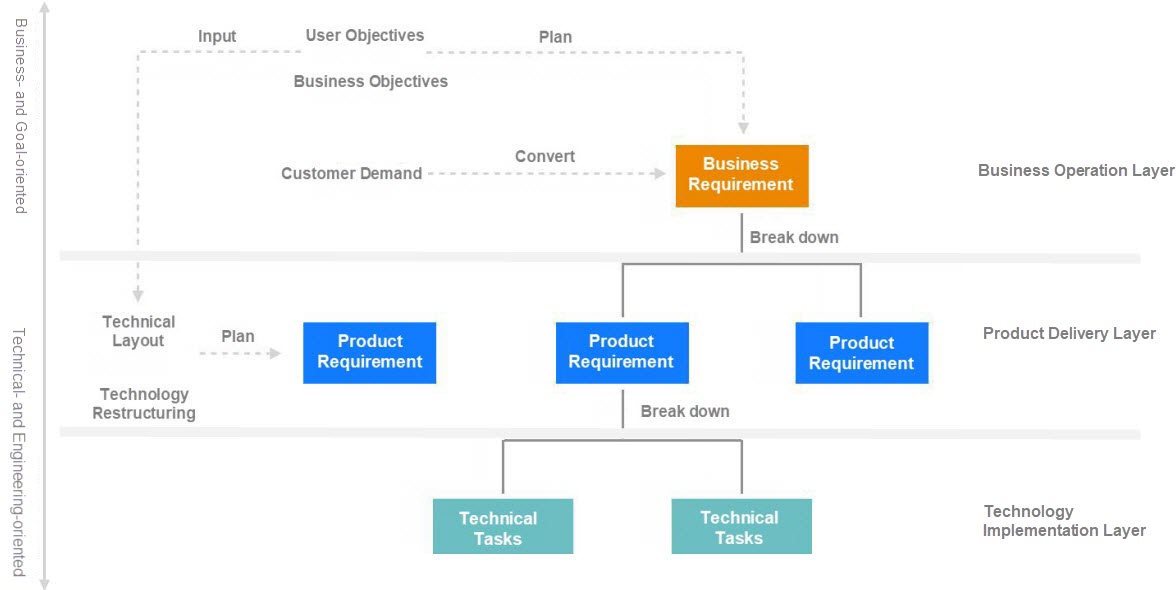
Three Layers of Business Requirement Delivery
As the top layer, the business operation layer is the core source that drives overall collaboration. We want to establish a business-driven collaboration mode that can streamline and coordinate the overall product delivery and technical work through businesses.
Business personnel are responsible for this layer. The core object they manage is business requirements, and the goal is the efficiency and effect of business requirement delivery.
At the business operation layer, the first thing is to manage the end-to-end delivery process of business requirements, which includes creating or receiving business requirements, planning requirement releases and versions, managing and tracking the requirement delivery, checking and releasing business requirements, giving feedback, and improving business design and planning.
When facing upwards, business requirements can be aligned to objectives. They can be created and planned based on objectives. They can also be translated into business requirements in response to customer demands. After a business requirement is released, a closed feedback loop should be formed based on the objectives and customer demands.
When facing downwards, business requirements are split into product requirements and assigned to the corresponding product delivery team. Meanwhile, it is also necessary to coordinate the delivery processes of relevant product requirements, align their progress, find bottleneck problems on time, and accelerate the implementation of business requirements.
The following three core capabilities must be built for the business operation layer to ensure business delivery efficiency and effectiveness:
These three capabilities form a complete closed loop of planning, delivery, and adjustment. Organizations can improve the efficiency and effectiveness of business delivery to meet customer demands and achieve business objectives by accelerating this closed loop and improving its effectiveness. This is also a long-term goal of the business operation layer.
The product delivery layer is managed by the Product Delivery Team, which includes product managers and the development team. They focus on and manage product requirements. The goal is to improve the continuous delivery ability of the product requirements, including the speed, predictability, and quality, to serve the delivery of business requirements.
At the product delivery layer, the first thing is to manage the end-to-end delivery process of product requirements. The process includes accepting product requirements split from business requirements, planning product requirements, scheduling or making iteration plans for product requirements, tracking and managing the delivery process of the product requirements, giving feedback, and improving product delivery efficiency. The product delivery layer associates with business delivery in the upper layer and technical and engineering activities in the lower layer.
When facing upwards, product delivery should be aligned with business delivery. First of all, the content, plan, and implementation progress of product requirements are aligned with the ongoing business requirements to ensure the business delivery speed and quality. Secondly, products should be planned and evolved in a future-oriented manner to ensure long-term efficiency. For example, the product layout should be planned, and preparation should be made in advance for future business development. Product restructuring should be carried out to eliminate technical debts.
When facing downwards, product requirements will be split into technical tasks, and different personnel will be responsible for them. At the product delivery layer, the responsible personnel coordinate the progress of technical tasks, find bottlenecks and problems on time, and ensure smooth and high-quality delivery of the product requirements.
You must build the following three core capabilities for the product delivery layer to improve the efficiency of the product requirement delivery:
These three capabilities form a closed loop from planning to delivery and improvement to ensure the efficiency of continuous product delivery.
Technical engineers, including developers and testers, are responsible for the technical implementation layer. The core object of the technical implementation layer is the changes of the system (application). Engineers split tasks or create changes based on product requirements and complete the development, testing, joint commissioning, and change release.
At the technical implementation layer, good tools, environments, and mechanisms should be offered to developers first, so they can finish their work efficiently and ensure the delivery quality. On this basis, the tasks of the technical implementation layer should be aligned with the tasks of the product delivery layer so the product requirements can be completed and delivered as soon as possible.
In summary, based on the requirement structure, the requirement delivery can be divided into three layers. Each layer has responsible roles. They must focus on completing their work and cooperate with each other to achieve a smooth and high-quality delivery of business requirements. Business is the source that drives this collaboration process and the goal of collaboration.
The previous section analyzed the collaboration layers. Each layer has objectives and special responsible roles, and the management objects and tasks differ at each layer. They should have an exclusive collaboration space to enable them to work more efficiently.
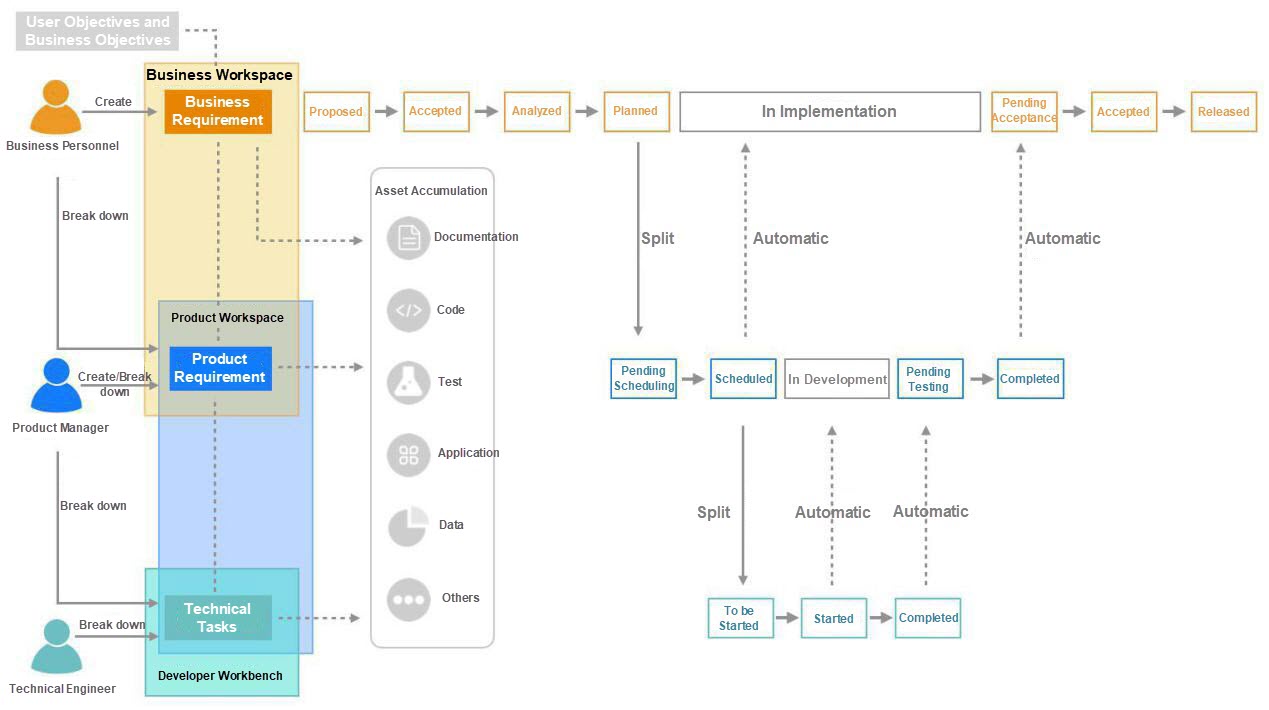
Business-Driven Hierarchical Collaboration
The preceding figure shows how business-driven collaboration is achieved. Collaboration is also divided into three layers according to the requirement layer. These three layers are interconnected to form a whole:
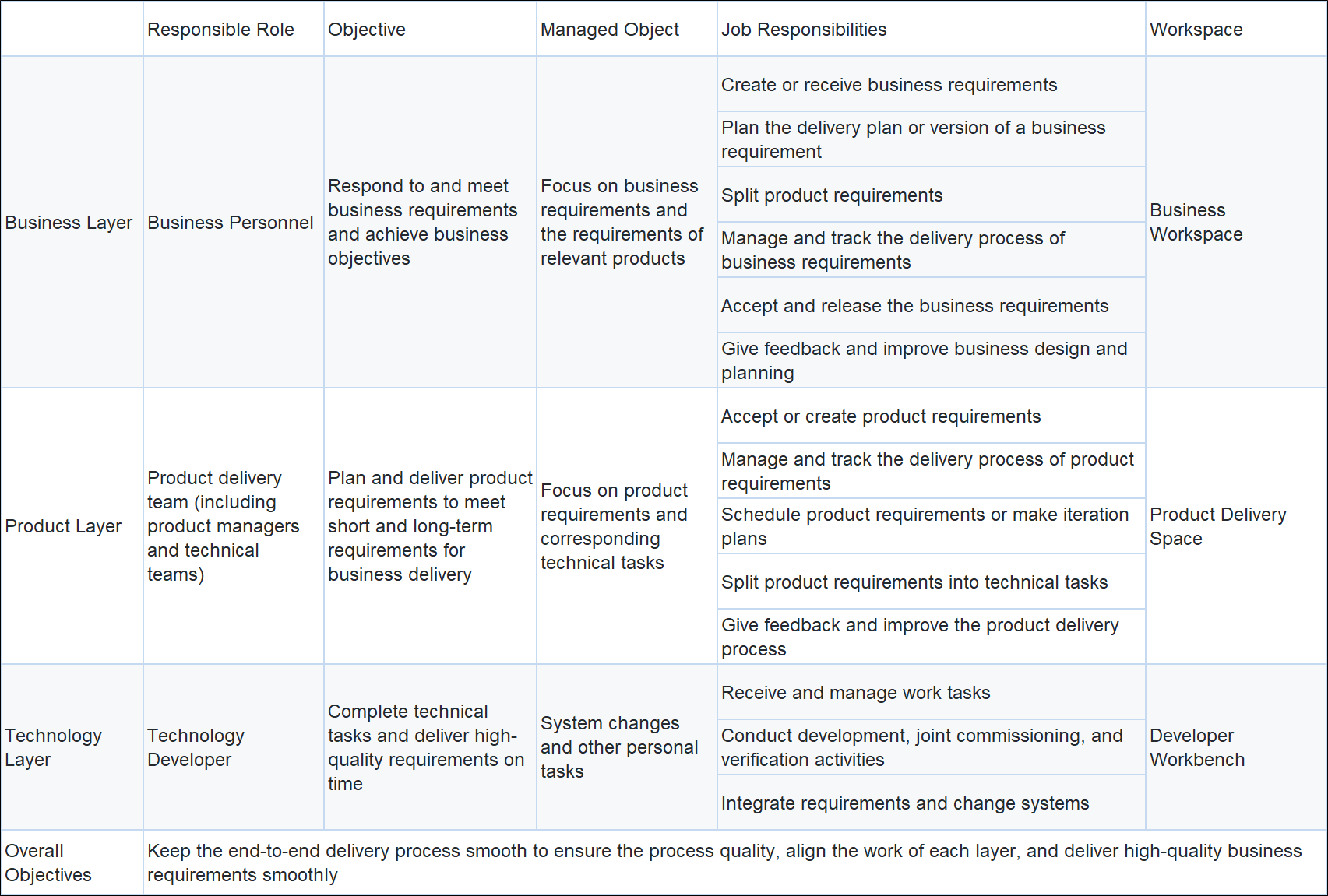
Workspace for Different Roles by the Responsibilities
The table above lists the features of each layer. The manager (or team) of each layer is different, and the objective, managed object, and job responsibilities vary at each layer. Relevant roles must have their own workspaces to improve the work efficiency and quality of each layer, including the business workspace, product delivery space, and developer workbench. These spaces can be configured in different digitization tools. Different R&D management tools are implemented in different ways. They can be an independent project or a logical view.
In a digitalization tool, the workspaces are distinguished by:
The business workspace supports the business requirements and product requirements. Most of the requirements in the workspace are business requirements, which are split into product requirements. A business requirement workflow needs to be clearly defined in the business workspace (please see Figure 2). The typical functions used in the business workspace include requirement splitting, business planning, and business review.
The product delivery space supports product requirements and work tasks. Most of the requirements in this workspace are product requirements, and they can be split into tasks. A product requirement workflow needs to be clearly defined in the product delivery space (please see Figure 2). The typical functions used in the product delivery space include iteration scheduling, task splitting, and progress statistics.
The workspace for each layer helps relevant roles focus on their work. At the same time, each layer is interconnected to form an organic whole. The following figure reflects the connections among them.
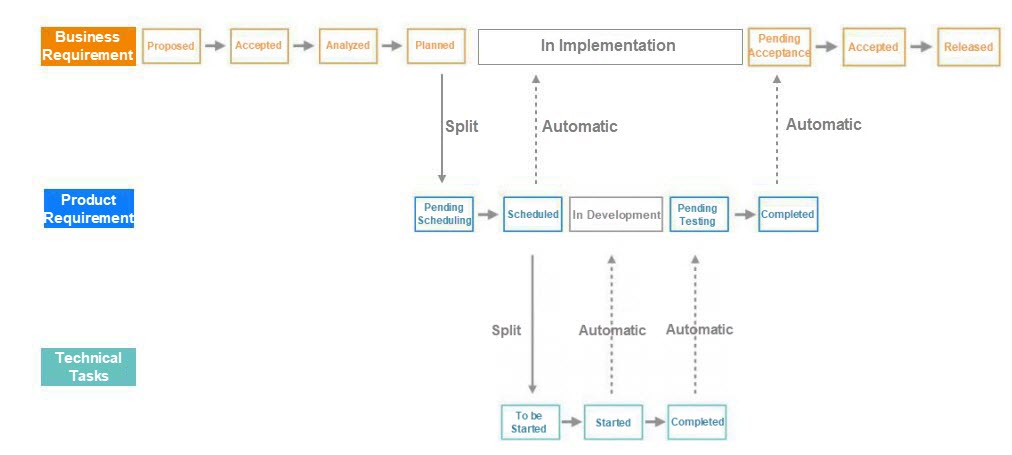
Connections between Each Layer
Business personnel manage the end-to-end delivery process in the business workspace. They create, accept, analyze, and plan requirements. The planned business requirements are split into product requirements, which are usually completed jointly by business personnel and product managers of each product. A split product requirement is assigned to the corresponding Product Delivery Team.
In the product delivery space, the Product Delivery Team accepts the split product requirements or creates requirements independently, carries out product design and requirement clarification, completes requirement scheduling, splits technical tasks, develops and integrates requirements, and completes the deployment.
Technical developers work in their personal workspace. They accept or split technical tasks, create changes, perform system development, integration, and joint commissioning, submit the code, complete continuous integration verification, and release changes.
The interaction between the business workspace and product delivery space is listed below:
The interaction between the product delivery space and the personal workbench is listed below:
These three layers are decoupled from each other, allowing different roles to focus on their respective responsibilities and goals and complete their work. They are interconnected to form an organic whole. With this organic whole, we drive the end-to-end delivery process by businesses, ensure the process quality, align the work at all layers, and achieve a smooth and high-quality delivery of business requirements.
Requirement delivery involves knowledge, and a large number of outputs are generated, such as discussion records, temporary or formal documents, UE/UI design, code, test cases, and application change records. All of these are important knowledge assets.
How can we manage the process of creating, organizing, and indexing these assets in a structured way? This is an important challenge. It is related to the efficiency of communication and cooperation and the value of the organization's intellectual assets.
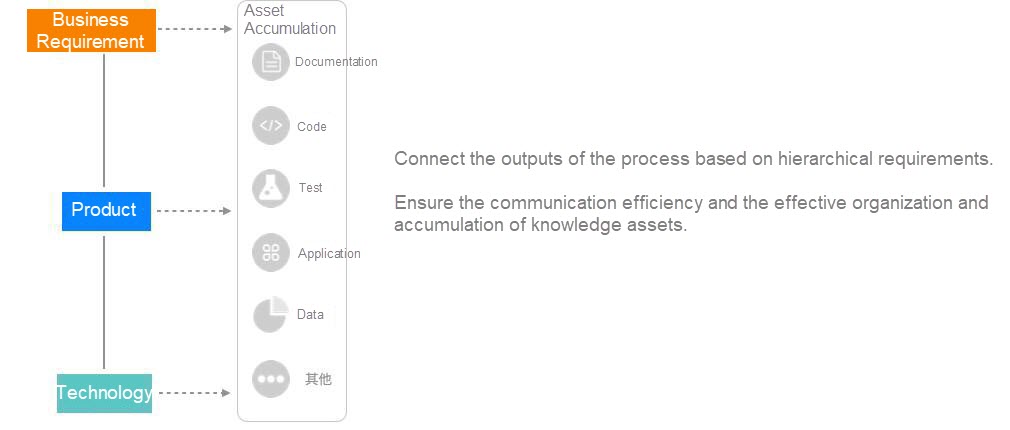
Correlation between the Output and Requirements in the Delivery Process
As shown in the figure above, an asset should be associated with a value unit in the R&D process. A value unit refers to the hierarchy of requirements introduced in the previous sections. In the value flow of the requirement delivery, we create and associate with related assets. For example, associate with the original business demand description when you create a business requirement, associate the business requirement analysis with relevant business analysis documents, associate with relevant documents and test cases during the product design process, and associate with relevant applications, changes, and code during task delivery.
On the one hand, this allows R&D digital assets to connect to customer value directly. On the other hand, it connects to value creation activities. The connection of different information avoids information islands and improves the efficiency of communication and cooperation. It accumulates assets in an orderly and structured manner, which is helpful for information retrieval and use. It also makes the most of digital assets in the R&D process.
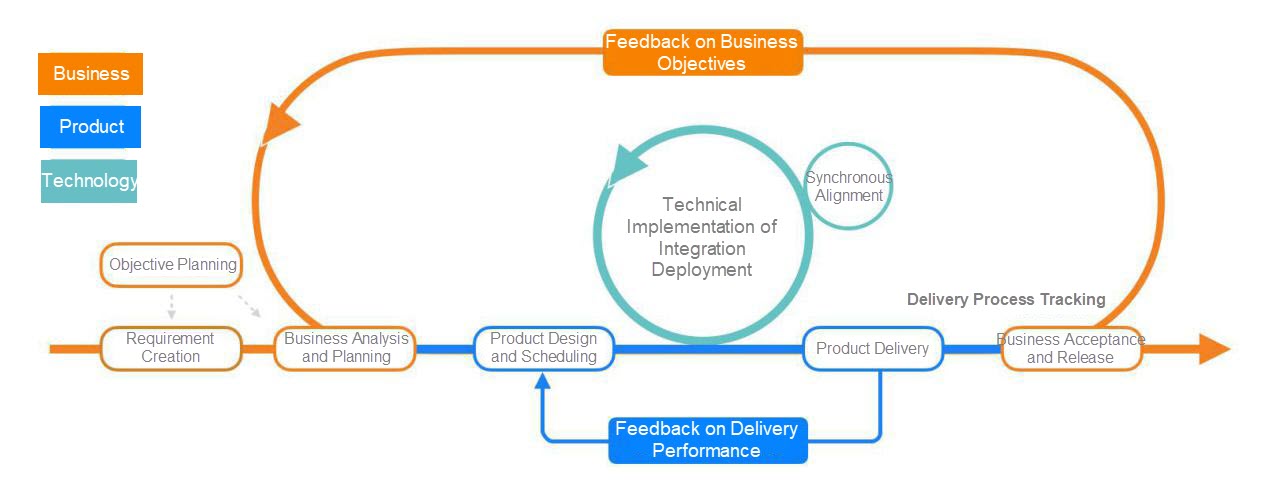
Overall Delivery Process and Closed Feedback Loop
This article introduced and defined the collaboration process driven by businesses. As shown in the preceding figure, this process involves three aspects: business, product, and technology.
The first part is the business delivery and closed feedback loop (the orange part in the figure). It focuses on the rapid response and delivery of businesses and the achievement of business objectives. The second part is the product delivery and closed feedback loop (the blue part in the figure). Its core focus is the rapid delivery of product requirements, product evolution, and the continuous improvement of product delivery efficiency. The third part is the technical and engineering practices (the green part in the figure). Its core focus is the basic setup and continuous improvement of technical and engineering capabilities to lay the foundation for product and business efficiency.
This delivery process is layered, decoupled, and interconnected, helping us connect all phases and layers of delivery. It coordinates the entire organization to maximize efficiency and achieve accurate business response, rapid iteration, and evolution.
Requirement Hierarchy - Alibaba DevOps Practice Guide Part 4
Product-Oriented Delivery - Alibaba DevOps Practice Guide Part 6

1,123 posts | 346 followers
FollowAlibaba Cloud Community - February 4, 2022
Alibaba Cloud Community - February 6, 2022
Alibaba Cloud Community - February 5, 2022
Alibaba Cloud Community - February 3, 2022
Alibaba Cloud Community - February 6, 2022
Alibaba Cloud Community - March 1, 2022

1,123 posts | 346 followers
Follow Alibaba Cloud Flow
Alibaba Cloud Flow
An enterprise-level continuous delivery tool.
Learn More DevOps Solution
DevOps Solution
Accelerate software development and delivery by integrating DevOps with the cloud
Learn More ChatAPP
ChatAPP
Reach global users more accurately and efficiently via IM Channel
Learn More Secure Content Delivery Solution
Secure Content Delivery Solution
Accelerate static and dynamic web content in a fast, reliable, and safe way using Secure DCDN (Dynamic Route for CDN)
Learn MoreMore Posts by Alibaba Cloud Community
Start building with 50+ products and up to 12 months usage for Elastic Compute Service
Get Started for Free Get Started for Free